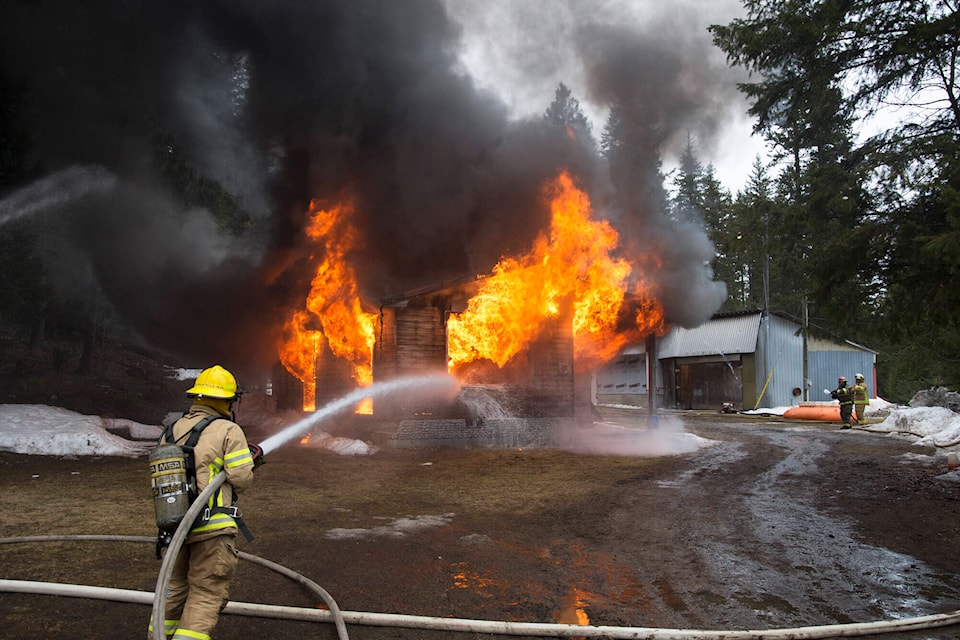Faster burning homes are a new normal for firefighters, making household safety measures like installing smoke alarms all the more important.
B.C.’s building and fire codes set out minimum requirements for safety, health, accessibility, fire and protection for homes and other structures. These have generally made for safer homes. But when a fire is involved, Sean Coubrough, deputy regional fire chief for the Columbia Shuswap Regional District (CSRD), said the time it takes for a home to become fully involved is less than it once was.
“The reality is just hotter fires,” said Coubrough. “It’s something we need to be aware of and it’s something we train our firefighters.”
Part of that training in the CSRD involves a focus on building construction. In a video presentation, Coubrough focuses on construction classifications, building materials and current building techniques that, in fire conditions, are things firefighters need to be aware of.
As one example, Coubrough explains in the video how modern construction techniques rely heavily on wooden I-beams and trusses which, in a fire, can “collapse early and suddenly.”
“These new wooden I-beams, they’re made often with these composite materials like particle board that are glued together…,” Coubrough explains. “They’re great in terms of cost effectiveness – lightweight, much easier for the crews to actually put up these buildings, much faster… and economical. For us as firefighters, however, these structural components are known to fail very quickly, and that could be roof supports, it could be floor supports, and we need to be aware of that as well.”
Newer construction may have composite building components and materials made of wood fibres, plastics or other substances joined by glues or resin binders. Under fire conditions, these can be very combustible. Coubrough said they can also produce a significant amount of toxic gas – a risk exacerbated by household furnishings.
Coubrough shows in the video how a fire in a home furnished with what he referred to as “legacy contents” – typically older furniture constructed using natural fibres (woods, wool and cottons), is slower to become a structure fire than a blaze inside a home furnished with “modern contents” – hydrocarbon-based products (things like foam, rubber, nylon, rayon, polypropylene).
“When you hear the beast has changed, this is a great example of how it has changed…,” Coubrough comments in the video. “It’s not your grandfather’s fire. If you have relatives who were firefighters before, the type of fires they would have experienced would have had lower heat release rates and it gave them a chance to get in there and actually do some work before the room flashed.”
Off gassing is also greater in the fire involving modern contents, and is also an increased risk in homes built with composite materials.
These are all considerations that are made at a fire scene in determining a course of attack.
Coubrough noted movies and television may have set unrealistic expectations of how firefighters respond to structure fires.
“We also have a saying in the fire service: We will risk a lot to save a lot, but we will risk nothing to save that which is already lost…,” said Coubrough. “There’s sometimes unrealistic expectations on the fire department on what we can do and what we will do when we arrive on scene. The whole idea of us just busting down the front door is just unrealistic.”
Read more: Shuswap fire chiefs applaud expanded cancer coverage for firefighters
Read more: Pay increase coming for paid-on-call Shuswap firefighters
To homeowners, Coubrough stressed due diligence, coming up with and practising an escape plan, having enough smoke alarms throughout your residence and changing their batteries twice a year, having fire extinguishers on hand and keeping important documents, including your home insurance, in a safe place – not necessarily in the home.
“We certainly want people to understand they are safe and… if you’re doing some due diligence on your on your side you’ll be able to protect your family,” said Coubrough. “Our job is protecting our firefighters, and having the public have a little more understanding of what we’re experiencing on the fire front, that would be a big thing – have people understand that we’re not stepping inside and not making entry because we’re scared. It really is a dangerous environment now. Stuff can be replaced but firefighters cannot.”
lachlan@saobserver.net
Like us on Facebook and follow us on Twitter
Sign up for our newsletter to get Salmon Arm stories in your inbox every morning.
